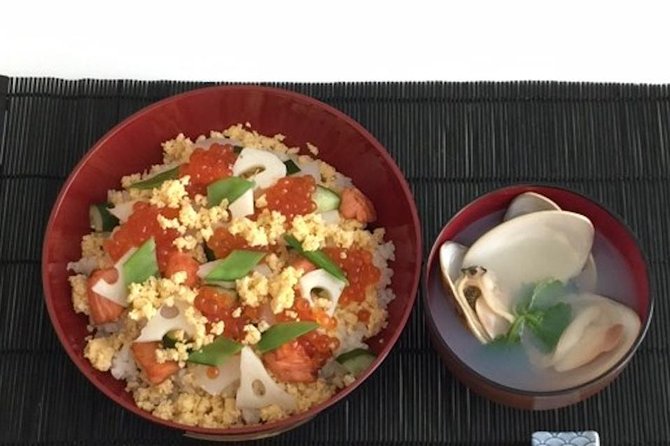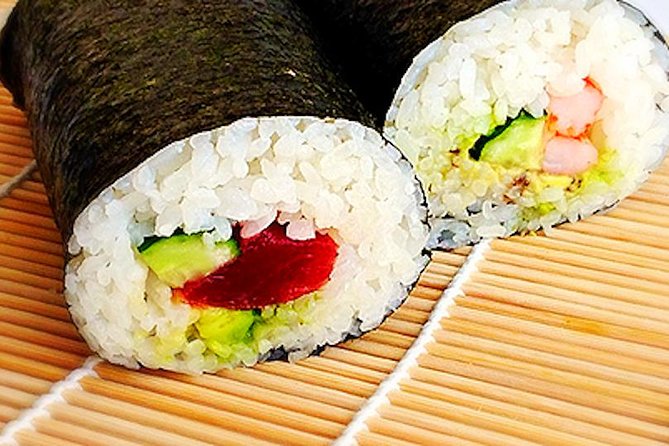Welcome to the captivating world of Japanese replica food making in Asakusa, where you can learn about the art of creating lifelike food replicas.
This 60-minute class, held at the Kappabashi Show Room, offers a hands-on experience to learn about the history of Japanese replica food and craft your own samples.
With English-speaking staff available, this class provides an enjoyable and educational experience for both locals and travelers.
Dive into the world of Japanese replica food making and witness the creativity and skill behind these remarkable creations.
Great News! You can reserve your spot for free with Viator. You can easliy cancel any time up to 1 day before without paying anything.
Quick Takeaways

- Japanese replica food is commonly seen in store windows throughout Japan.
- The class takes place at Kappabashi Show Room in Asakusa.
- Participants learn about the history of Japanese replica food and make their own fake food samples.
- Visitors can take home one of their creations as a souvenir.
Not for you? Here's a few more great tours and experiences nearby.
Overview of Japanese Replica Food

Japanese replica food is a fascinating art form that has become synonymous with Japan’s culinary culture. The Japanese replica food market has been thriving for decades, with these realistic food models being prominently displayed in store windows throughout the country. These replicas are meticulously crafted to look like the real thing, from sushi rolls to bowls of ramen to bowls of rice.
Some of the most popular fake food items include tempura, sushi, and bowls of noodles. These replicas are so detailed and lifelike that they can often be mistaken for the real thing. They serve as visual aids for customers, allowing them to see exactly what they will be getting before they order.
The Japanese replica food market continues to evolve and innovate, offering a wide range of options for both display and practical use.
You can also read our reviews of more tours and experiences in Tokyo.
Class Details and Location

Located at the Kappabashi Show Room in Asakusa, the class offers a comprehensive experience in the world of Japanese replica food.
Participants have the option to choose from a range of potential start times in the morning and afternoon, allowing for flexibility in scheduling.
The class begins with an informative session on the history of Japanese replica food, tracing its origins back to 20th-century Japan.
Following the introduction, participants get hands-on experience in making their own fake food samples, such as artificial tempura and a replica of a head of lettuce.
As a special treat, each participant gets to take home one of their creations as a unique souvenir.
With its engaging and interactive nature, this class promises to provide a memorable experience for all participants.
History of Japanese Replica Food

The origins of Japanese replica food can be traced back to the 20th century in Japan, where it first emerged as a unique and innovative art form. Over the years, it has evolved into a beloved and highly skilled craft.
Here are four key aspects that highlight the evolution and significance of Japanese replica food:
- Cultural Preservation: Japanese replica food plays a crucial role in preserving traditional culinary culture and showcasing the visual appeal of dishes.
- Artistic Mastery: The creation of replica food requires immense skill and attention to detail, making it a true art form.
- Realism: Through continuous advancements in materials and techniques, Japanese replica food has become incredibly lifelike, often indistinguishable from the real thing.
- Commercial Impact: Replica food has become an essential marketing tool for restaurants and food establishments, attracting customers with its enticing displays.
The history and evolution of Japanese replica food showcases its importance in Japanese culture and its impact on the culinary industry.
Making Fake Food Samples

To delve into the art of making fake food samples, one can participate in a 60-minute class in Asakusa, where the history and techniques of Japanese replica food are taught.
The class offers a unique opportunity to learn about the benefits of Japanese replica food and to try your hand at creating your own fake food samples. The techniques taught in the class include molding, painting, and assembling various materials to create realistic-looking replicas of popular Japanese dishes.
Participants can learn how to make artificial tempura, sushi, and even a replica of a head of lettuce. This hands-on experience allows you to explore the intricacies of Japanese replica food and gain a deeper appreciation for the craftsmanship involved in creating these visually appealing and tantalizing food samples.
Additional Information About the Class
Participants in the Japanese replica food making class in Asakusa can expect a maximum capacity of 15 travelers for each session. This ensures a personalized and intimate experience for all participants.
To ensure a smooth and enjoyable class, there are a few class requirements to note. Firstly, the minimum age requirement is 5 years old, making it suitable for families with young children.
Secondly, visitors are unable to simply watch the class due to room capacity limitations, ensuring that everyone gets a hands-on experience.
However, it is important to note that the facility is not wheelchair accessible, which may limit accessibility for some individuals.
Despite this limitation, the class provides an engaging and interactive experience for all participants.
- Things To Do In Tokyo In November
- Things To Do In Tokyo In March 2024: Tokyo’s Best March Events
- Things To Do In April In Tokyo 2024: Tokyo’s Best April Events
- Things To Do In Tokyo In December 2023: Tokyo’s Best December Events
- Tokyo’s Weather And Seasons: A Guide For The Perfect Visit
- Tokyo Midtown Cherry Blossom Season
Cancellation Policy for the Activity
Cancellation Policy for the Activity is outlined in the article ‘Japanese Replica Food Making in Asakusa W. ENG Guide’.
It is important to be aware of the refund policy and any age requirements before booking this activity.
In the event that you need to cancel, a full refund will be provided if the cancellation is made at least 7 days in advance.
However, if the cancellation is made less than 2 full days before the start time, no refund will be given.
For cancellations made 3-6 full days before the start time, a 50% refund will be offered.
It is also worth noting that changes made less than 6 full days before the start time will not be accepted.
Plus, please be aware that there is a minimum age requirement of 5 years for this activity.
Reviews of the Japanese Replica Food Making Experience

The reviews of the Japanese Replica Food Making experience in Asakusa provide insight into the overall satisfaction and enjoyment of participants.
Here are some key points from the reviews:
- Participants express high levels of customer satisfaction, with many stating that they had a fantastic time during the class.
- The hands-on experience is highlighted as a major highlight of the activity, allowing participants to create their own fake food samples.
- The presence of English-speaking staff is praised, as it helps facilitate communication and enhances the overall experience for non-Japanese speakers.
- The opportunity to take home one’s creations is mentioned as a positive aspect, allowing participants to showcase their work and serve as a unique souvenir.
Frequently Asked Questions
Is Prior Experience or Knowledge in Cooking Required for the Japanese Replica Food Making Class?
No prior experience or knowledge in cooking is required for the Japanese replica food making class. The class focuses on the importance of presentation in Japanese replica food making and offers the benefits of learning this art form, even without prior cooking experience.
Can Participants Choose the Specific Types of Fake Food Samples They Want to Make?
Participants in the Japanese Replica Food Making class have the opportunity to choose and create customized replicas of various fake food samples. They can bring to life unique designs such as artificial tempura or a replica of a head of lettuce.
Are There Any Restrictions on What Materials Can Be Used to Create the Fake Food Samples?
There are safety regulations in place for the materials used in creating replica food samples. Environmental considerations are also taken into account during the process to ensure the sustainability and non-toxicity of the materials used.
Is There a Time Limit for Creating the Fake Food Samples During the Class?
During the Japanese replica food making class, participants are given a designated time to create their fake food samples. Time management is crucial in ensuring that participants can showcase their creativity and precision in crafting their replicas.
Can Participants Bring Their Own Materials or Tools for the Class?
Participants are not allowed to bring their own materials or tools for the class. The purpose of the class is to provide a comprehensive experience, including the use of specific tools and materials.
The Sum Up
To sum it up, the Japanese replica food making class in Asakusa offers a unique opportunity to explore the fascinating world of lifelike food replicas.
With a rich history and hands-on experience, participants can learn about the artistry and craftsmanship behind creating these incredible creations.
With English-speaking staff and the chance to take home a souvenir, this class is a must-visit for both locals and travelers looking to delve into the creativity of Japanese replica food making.
More Guided Tours in Tokyo
- Shinjuku Golden-Gai and Kabuki-Cho Bar Hopping With Master Guide
- Self Guided Tour in Karuizawa With Bullet Train Ticket
- Private Worship Ceremony and Guided Tour at Kanda Shrine in Tokyo
- Private Night Walking Tour Shibuya Bar Hopping W. Master Guide
- Private Tokyo Shinjuku Bus Tour With Licensed Guide
- Tailored Private Tour With a Licensed Tour Guide
More Food & Drink Experiences in Tokyo
- Private Wine Tasting Tour in Yamanashi Prefecture
- Shibuya Best Vegetarian Vegan Friendly Food Tour
- Special Breakfast Onigiri Tasting Activity for The Early Birds
- Premium Sake Tasting & Pairing Experience in a Historical Brewery
- Tokyo Street Food Tour – 7 Japanese Foods
- Japanese SAKE Lesson & Tasting at Izakaya Pub
More Tour Reviews in Tokyo
- Tokyo Airport Transfers: Tokyo City to Tokyo-Narita Airport NRT in Business Car
- Private & Custom TOKYO Day Tour Toyota COMMUTER (Max 13 Pax)
- Private Transfer From Tokyo Port to Tokyo Haneda Int Airport(Hnd)
- Shinjuku Golden-Gai and Kabuki-Cho Bar Hopping With Master Guide
- SHIMOKITAZAWA Local Walking Tour
- Small Group Iaido Class in Tokyo
Not for you? Here's more nearby things to do in Tokyo we have reviewed
- Tokyo Airport Transfers: Tokyo City to Tokyo-Narita Airport NRT in Business Car
- Private & Custom TOKYO Day Tour Toyota COMMUTER (Max 13 Pax)
- Private Transfer From Tokyo Port to Tokyo Haneda Int Airport(Hnd)
- Shinjuku Golden-Gai and Kabuki-Cho Bar Hopping With Master Guide
- Small Group Iaido Class in Tokyo
- Private Casual Photoshoot Tour in Tokyo
- Private Transfer From Tokyo City Hotels to Sendai Cruise Port
- Private Transfer From Tokyo Narita Int Airport(Nrt) to Tokyo Port
- Okonomiyaki Cooking,Japanese Sake Free Flowing Experience
- Mt. Fuji Majestic Tours : Shinjuku to Arakurayama and Beyond
- Private Transfer From Tokyo Cruise Port to Tokyo Hotels
- Private Transfer From Nagasaki Hotels to Nagasaki Cruise Port



